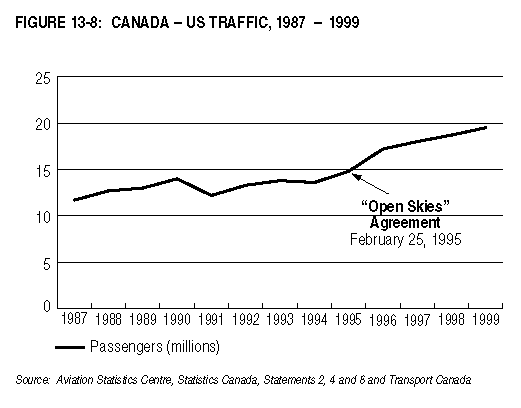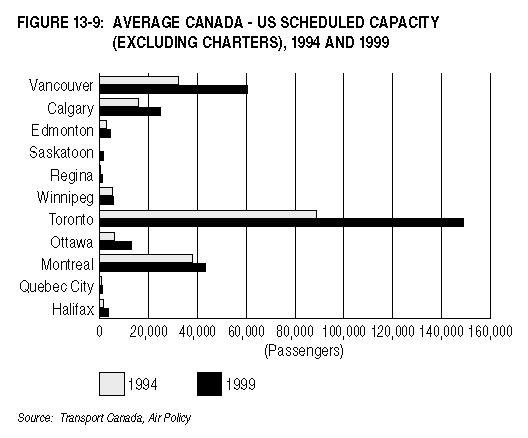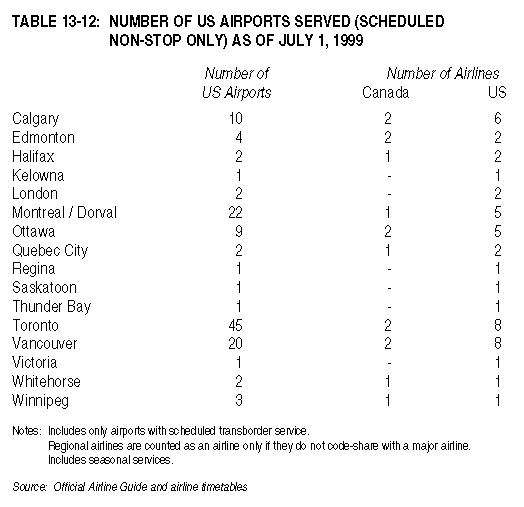13
PASSENGER
TRANSPORTATION
Air Transportation
Government Policy Initiatives
In May, Canada was an active participant, as a Member of the
Council and host nation, in the meeting of the International Civil
Aviation Organization (ICAO) in Montreal. The Montreal Convention
developed at this meeting is a new legal regime dealing with the
liability of air carriers in the event of the death or injury
of a passenger, loss of baggage or cargo, or delay of international
flights. Once ratified by at least 30 of the ICAO's 185 member
states, the Montreal Convention will allow victims to claim damages,
regardless of whether the carrier is at fault. It will also permit
damage claims resulting from a passenger death or injury to be
filed in the country where the victim lived and will require airlines
to provide immediate financial assistance to victims' relatives,
with amounts to be deducted later from the final settlement.
The major feature of the Montreal Convention is the concept
of unlimited liability, in contrast to the 1929 Warsaw Convention
it replaces. Whereas the old regime set a limit of approximately
US$8,300 in case of death or injury to passengers, the Montreal
Convention introduces a two-tier system. The first tier provides
for the strict liability of a carrier of up to 100,000 Special
Drawing Rights (approximately US$194,325Note 1) regardless of
fault by a carrier. The second tier is based on a presumption
of fault of a carrier and has no limit of liability. The Government
of Canada is committed to begin ratifying the Montreal Convention
in 2000.
On the domestic front, the period from August to December 1999
saw a number of private sector and government initiatives related
to the restructuring of the Canadian airline industry. See Chapter
11, Structure of Transportation Industry, for more details.
Bilateral Initiatives
During 1999, there was a progressive revision of Canada's bilateral
agreements related to the opportunities created by the federal
Transport Minister's June 1998 statement on international air
policy. This statement permitted Air Canada and Canadian Airlines
each to select five countries to serve on a code-share basis;
in each country, the other would be the designated Canadian
air carrier for own-aircraft flights. Further to that statement,
and following efforts made during 1998, Canada successfully renegotiated
its bilateral agreements with Thailand and Finland in 1999.Note
2
Air Canada became entitled to provide code-share services to
Thailand but is restricted to routings across the Atlantic.
(Canadian Airlines suspended service to Thailand on January 25,
2000.) Thai International Airways continues to enjoy access
to Toronto and Montreal from all cities in Thailand
but presently does not exercise these rights.
Canadian Airlines gained the right to provide code-share service
with Finnair, while Air Canada could use its code-share services
with SAS and Lufthansa. Full liberal code-sharing provisions will
take effect in the summer of 2000, allowing each country to designate
multiple airlines to provide direct, intermediate and beyond services.
The Minister also announced that the Taiwan market would become
eligible for a second designation. As a result, both Air Canada
and EVA Air introduced service between Vancouver and Taipei in
the summer of 1999, EVA Air on June 3 and Air Canada on July 5.
Both airlines carry each other's code on their flights. Foreign
policy considerations preclude there being a bilateral air agreement
between Canada and Taiwan, but air services are unabled pursuant
to a ministerial directive with the concurrence of the Minister
of Foreign Affairs.
New agreements were reached with Romania and the United
Arab Emirates. The revised agreement with Romania permits Air
Canada to offer service to Bucharest via Frankfurt, code-sharing
with Lufthansa. Romania's airline, TAROM, gained the right to
serve Montreal from Romania and to fly beyond to New York and
Chicago. TAROM introduced twice-weekly, own-aircraft service to
Montreal in June.
Canada also concluded an inaugural agreement with the United
Arab Emirates, permitting each country to designate an airline
to provide service between any city in either country, either
with its own aircraft or by code-sharing. Air Canada became
entitled to offer code-share services via London with Emirates
Air and via Frankfurt to Dubai with either Lufthansa or Emirates
Air.
All bilateral negotiations were suspended from August until
the end of 1999 while industry restructuring took place. Table 13-6
lists the bilateral air agreements in force at the end of 1999.

Domestic Services and Traffic
Domestic passenger traffic continued to grow in 1998, albeit
at a lower rate than 1996 and 1997. Preliminary airport statistics
indicate moderate passenger growth of 2.4 per cent for 1999.
The change in the level of passenger traffic is attributed in
part to changes in service levels and patterns provided by
the industry.
Table 13-7 summarizes the growth of domestic air travel over
the past ten years. It shows five consecutive years of growth
since 1994. The regional distribution of passenger traffic is
portrayed in Figure 13-7.


Airlines served several cities with new or additional scheduled
air services during 1999, as shown in Table 13-8.

In some cases, these services were a competitive response to
existing services. Air NorTerra's Ottawa-Iqaluit service, for
example, competed with First Air's service. WestJet's Grande
Prairie-Edmonton service competed directly with those of AirBC
and Canadian Regional. The route between Calgary and Halifax was
also contested between the new service provided by Canadian Airlines
and the additional service provided by Air Canada.
Operators providing regional and local air services in Quebec
and Atlantic Canada moved to provide air services to most communities
served by InterCanadien immediately after it suspended its operations
in November. Because November is traditionally in the low traffic
season, much of the traffic in Quebec and Atlantic Canada that
might not have been accommodated otherwise was absorbed by
Air Nova. There was also a gradual restoration of service during
December by InterCanadien's commercial partners, Canadian Regional
and Ontario Regional. Ontario Regional had already assumed many
of the regional routes served by InterCanadien during
October. As a result of InterCanadien's suspended operations,
however, Charlo and Chatham/Miramichi, New Brunswick, and
Stephenville, Newfoundland, were without air service.
Table 13-9 summarizes the level of competition in the top 25
markets, in terms of seats offered. It shows that Air Canada
and Canadian Airlines combine for more than 50 per cent of each
of the markets. WestJet's penetration of the western Canadian
market is notable, considering that the airline has been operating
only four years. Also of note are the inroads made by Canada's
jet operators of long-haul charter air services -- Air Transat,
Canada 3000 and Royal Airlines -- which had virtually no domestic
presence prior to 1988.

Table 13-10 summarizes the number of non-stop links to airports
in the National Airport System (NAS). It indicates that the number
of air links depends not only on the amount of traffic generated
at a site but also (as with Winnipeg and Yellowknife) on
each airport's role as a gateway to remote communities.

Canada-US Transborder Services and Traffic
Growth in transborder traffic continued for the fifth consecutive
year since the signing in February 1995 of the Canada-U.S.
Air Transport Agreement (i.e. the "Open Skies"
Agreement). Between 1994, the last full year before the new
air agreement took effect, and 1998, this market grew from
13.6 million passengers to 18.7 million passengers. Preliminary
airport statistics indicate that moderate growth continued in
1999, with an estimated 4.2 per cent increase. Figure
13-8 plots the growth in this market.

In the transborder market, Canadian airlines have dramatically
improved their percentage of passengers, to the extent that in
1998 they carried slightly more passengers than US airlines. This
increase, however, did not occur at the expense of the US
industry, whose airlines have carried 20 per cent more traffic
since 1994. Table 13-11 encapsulates the growth of the transborder
market since the new agreement in 1995. Appendices 13-1 and 13-2, show entry, exit and ongoing activity
in the Canada-U.S. market in terms of airline, air carrier domicile and
points served.

Figure 13-9 compares the number of seats currently offered
in the transborder market with those offered in 1994. There is
a marked improvement in the number of seats offered in most
communities.

Table 13-12 shows the number of US airports served from each
NAS airport. These numbers are proportional to the number
of transborder passengers served at these sites. Note that the
table does not include services offered by the Canadian leisure
airlines (Air Transat, Canada 3000, Royal Airlines and Sky Service),
although these airlines do play a major role in US resort
destinations, particularly during the winter months.

Very high levels of competition and poor financial results
prompted a realignment of transborder services along the West
Coast in the spring of 1999. Canadian Airlines suspended its service
to San Jose in January and ceased services to Seattle, Portland,
Las Vegas and San Diego in April. Withdrawal of these services
was accompanied by the announcement of a code-share agreement
between Canadian Airlines and Alaska Airlines, which serves seven
US cities from Vancouver along with its affiliate, Horizon
Air. The decision by Canadian Airlines to code-share with Alaska
Airlines closely followed American Airlines' announcement of a
code-share with Alaska Airlines in US domestic markets. In a related
move, American Airlines acquired start-up Reno Air during 1999.
As part of the realignment of services, Reno Air withdrew from
the Vancouver market when it terminated its Vancouver-Reno service
in April.
Despite the withdrawal of services along the West Coast, Canadian
Airlines was active in other markets in 1999. Edmonton-Chicago
and Calgary-Houston routes were added to the summer schedule.
An Ottawa-Raleigh service was added by Canadian Regional in January
1999. Canadian Airlines continued service in the high-density
markets between Vancouver and Los Angeles/San Francisco.
American Airlines fully restored its code-share relationship
with Canadian Airlines in 1999. American Airlines had been forced
to reduce code shares during 1998 to comply with the contract
with its pilots.
Air Canada continued its expansion in transborder markets,
adding eight new routes in 1999, four of them with its own equipment.
The most significant of the new routes were Toronto-San Diego,
and a new Winnipeg- Denver service by its subsidiary, Air BC.
Air Canada also launched twice daily non-stop service between
Chicago and Calgary in May. In July, Air BC launched a second
daily non-stop flight from Edmonton to Denver shortly after
Delta Airlines' exit from the Edmonton-Salt Lake City market.
One month later, Air Canada launched its 50th new route since
Open Skies with service between Ottawa and Washington's National
Airport. In the fall, Air Canada launched daily non-stop service
between Halifax and Washington Dulles.
US carrier Continental Airlines added three new services, including
a new Quebec-Newark service by Continental Express. With its spring
1999 schedule, Delta Airlines terminated service on three
transborder routes: Edmonton-Salt Lake City, Ottawa-New York/LaGuardia
and Toronto-Boston. In December, US Airways reinstated its Toronto-Washington/Reagan
services after a four-year hiatus.
Table 13-13 lists the new transborder routes introduced during
1999.

Other International Services and Traffic
The number of international passengers grew by 5.9 per cent
in 1998, with most of the growth in the Atlantic and Southern
markets. Table 13-14 shows the growth of international passenger
traffic between Canada and countries other than the US from 1991
to 1998. The pattern of very high growth of passenger traffic
across the Pacific was interrupted in 1998. However, even
the small growth figures can be considered a positive result in light
of the weakness of the Asian economy.

Moderate growth is expected to continue into 1999; preliminary
airport statistics show a further 5.9 per cent growth in international
passenger traffic.
Air Canada launched numerous new services in 1999, including
routes to Copenhagen and Taipei. It launched additional services
on a code-share basis to Amman, Amsterdam, Bucharest, Helsinki,
Dubai and Abu Dhabi. Air Canada also increased the frequency of
its flights between Toronto/Ottawa and London.
In May, Air Canada initiated five weekly non-stop flights between
Toronto and Copenhagen. The SAS code is being carried on
the transatlantic sector and beyond Toronto, while Air Canada
gains access to the destinations beyond the SAS hub at Copenhagen.
In June, Air Canada and EVA Air jointly launched a new Vancouver-Taipei
non-stop service, with each carrier flying between the two points
on alternate days.
In March, Air Canada and Royal Jordanian announced summer plans
for code-share service between Canada and Jordan via London. In
May, Air Canada and British Midland announced the launch of code-share
service to Amsterdam. In August, pursuant to Canada's new bilateral
agreement with the United Arab Emirates, Air Canada launched daily
code-share service to Dubai and Abu Dhabi in co-operation with
Emirates Air.
Air Canada also announced plans to extend its network to Mexico
in September, using opportunities gained under the Minister's
June 1998 statement.
Further to the Minister's January 1999 statement allowing the
designation of a second carrier to serve Taiwan, Air Canada introduced
three weekly flights between Vancouver and Taipei in July. Air
Canada's new service followed the introduction of three weekly
flights by EVA Air in June. Both airlines have agreed to carry
the other airline's code on their flights.
Air Canada permanently suspended its London-Delhi service in
June. The service had operated four flights per week during
the winter traffic season. Capacity on the route was reallocated
to the London-Toronto/Ottawa routes. Its Edmonton-London flights
were suspended in the fall.
Canadian Airlines also had a few changes in its winter 1999/2000
schedule, taking over Toronto-Milan service from Alitalia, which
had introduced service in June following completion of improvements
at Milan's Malpensa airport. Under an agreement between the two airlines,
Alitalia flies to Milan and Rome during the summer traffic
season and Canadian Airlines operates during the winter traffic
season. Canadian Airlines' year-round Montreal-Rome service was
an exception to this arrangement. In April, Canadian Airlines
started daily service from Toronto to Moscow via London in co-operation
with British Airways.
At the same time, Canadian Airlines suspended non-stop Toronto-Tokyo
service and transferred those frequencies to support its
Vancouver-Tokyo service. The airline also announced that it was
suspending service to Bangkok and Manila as a result of the new
code-share agreement with Cathay Pacific. Services to Manila were
suspended in the fall of 1999, and services to Bangkok are
scheduled to end in January 2000.
Other changes include the introduction of Toronto- Budapest
flights by Malev and Montreal-Bucharest flights by Tarom during
the summer. Malaysia Airlines cancelled its Vancouver-Kuala Lumpur
flights in January. Iberia suspended its Montreal-Madrid service
in October.
In December, Air Canada and Canadian Airlines agreed to
the transfer of authorities that would permit the reinstitution
of daily non-stop Toronto-Tokyo services. Air Canada indicated
that it intended to inaugurate a direct Toronto-Tokyo service
in the summer of 2000. Air Canada also announced that it would
begin daily Toronto-Hong Kong service and would seek to use dormant
authorities for several other routes. All changes planned
are subject to the successful negotiation of the necessary
route rights with other countries.
Table 13-15 shows the number of international destinations
served by scheduled airlines from NAS airports. Note that
the bulk of international traffic is concentrated in Canada's
three largest cities: Montreal, Toronto and Vancouver.

Appendix 13-3
lists the international air services provided to and from Canada
as of the end of 1999. These include foreign markets served
by Air Canada and Canadian Airlines, as well as Canadian markets
served by foreign carriers. This appendix also provides a
partial list of foreign markets served by charter air carriers.
It shows that 43 countries and territories currently serve same-plane
scheduled services from Canada. Canadian air carriers
serve 25 of these countries.
Air Transportation
- Appendix 13-1 Status of Transborder
Scheduled Air Services by Airline Domicile, 1991 - 1998
Appendix 13-2 Status of Transborder Air
Services as of December 31, 1999
Appendix 13-3 International Air Services
as of December 31, 1999 (excluding Canada-US Transborder
Air Services)
NOTES:
1
On February 28, 2000, one Special Drawing Right = C$0.5146.
2
As a follow-up to the statement, Canada renegotiated its bilateral
agreements with New Zealand, Mexico and the Netherlands in 1998
to facilitate the authorization of new services pursuant to the
Minister's statement. Canadian Airlines was given the right to
provide code-share services to Finland.
|

